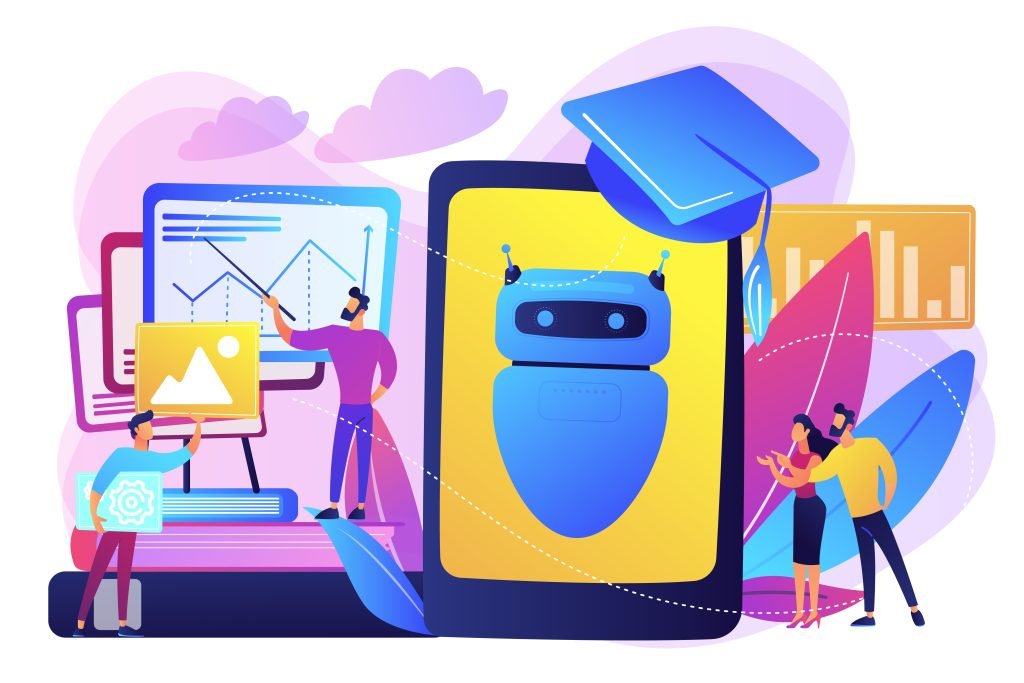
Few technological advances have caused as much anxiety, legislation, and excitement at the same time as Artificial Intelligence (AI). The integration and pervasiveness into our lives have been revolutionary and polarizing. AI in education is highly debated.
AI will affect the way we teach and kids learn. As it continues to shape how we live, learn, and teach, it’s essential to understand its evolution, applications, and implications in education.

AI: From Concept to Classroom
The term “Artificial Intelligence” was first coined in 1956 by John McCarthy, the oft-regarded “father of AI” when computer scientists began exploring the idea of machines possessing human-like intelligence.
However, it didn’t pick up steam until the last two decades, thanks to advancements in computers and algorithms. Now, it is used by most people in developed nations daily, sometimes without them realizing it, from interacting with voice assistants like Siri and Echo to grammar and spelling help from Grammarly.
AI has made its way into the classroom. I am cautiously optimistic about how beneficial it can be when executed safely.
AI in Education: A Game Changer
One of the most popular applications of AI in schools is enhancing productivity and personalizing learning experiences. AI-powered and supported curriculum tools aim to engage kids with learning content, offering interactive, immersive, and customized learning experiences.
Pickatale is a popular interactive eLibrary with roots in the UK and Norway. Pickatale uses AI-powered short intro videos to introduce important figures in history, like Charles Darwin, and to explain historical events as a lead-in to informational texts. This gets even the most reluctant readers hooked to start reading the book.
Productivity tools for students can help with writing and note-taking and can be a game-changer for special needs students by arming them with tools to help them learn and study the way they learn best, especially if that is not reading from plain text. Teachers and administrators can use AI tools to build assessments, help with lesson planning, view and analyze data to better serve all their students, and track student wellbeing with innovative tools like Holotracker, which requires very little time throughout the school year and provides real-time comprehensive data at the school and district level throughout the year and provides AI-driven summaries perfect for report cards.
These are just some of the innovative uses of AI that I have seen in 2024 alone. I would not attempt to write an exhaustive list but encourage everyone in education to explore what is available for their needs.

Overcoming Resistance: Embracing Change
Despite its widespread adoption in everyday life, AI faces resistance in schools and workplaces.
Some educators and professionals fear that AI may replace human jobs or compromise the quality of education. However, embracing AI doesn’t mean yielding to automation; rather, it offers opportunities to augment human capabilities and efficiency, especially in areas of education by supporting individualized instruction and collecting and analyzing data to address signs of social and emotional distress and crisis.
Government regulations play a crucial role in navigating the ethical and legal implications of AI. Countries like France have implemented regulations to ensure responsible AI usage in classrooms, safeguarding student privacy and promoting transparency. Similarly, the United States is exploring ways to address concerns surrounding data privacy and algorithmic bias.
Exciting Tools Shaping the Future of Education
Several innovative AI tools are reshaping the educational landscape. ChatGPT facilitates personalized learning experiences through natural language processing. Its ability to generate human-like responses fosters engaging conversations and supports students’ cognitive development.
These tools allow students to explore complex concepts interactively.
Embracing the Future with Common Sense
As AI continues to evolve and become a larger part of our lives, it’s important to approach its development and integration with common sense and critical thought. Rather than fearing what it can do and that it will replace the need for humanity, we should harness AI’s potential to foster collaboration, differentiation, and creativity in education.
By leveraging AI-powered tools responsibly, educators can personalize learning experiences, identify students’ individual needs, and promote lifelong learning.
AI’s presence in education is not a distant possibility but a reality that is here and shaping the future of learning. By understanding its origins, applications, and challenges, we can navigate the evolving landscape of education with confidence and foresight. As AI continues to evolve and “get smarter,” let us embrace its potential as a catalyst for positive change in education and our lives.
Are you looking for AI tools in education? I have a vast network of Educational content and can help you to find what you need!
Book a call on my Agenda to discuss how I can connect you to new AI Educational Technologies!
